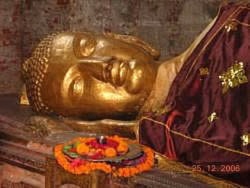Difference between revisions of "Prayer for Rain Sutra"
Jump to navigation
Jump to search
(Created page with "thumb|250px| <poem> '''Prayer for Rain Sutra''' [請雨経] (Chin Ch’ing-yy-ching; Jpn Shou-kyo ) A sutra that details the ritual of prayer for rain an...") |
|||
| Line 1: | Line 1: | ||
[[File:Sb7.jpg|thumb|250px|]] | [[File:Sb7.jpg|thumb|250px|]] | ||
<poem> | <poem> | ||
| − | '''Prayer for Rain Sutra''' | + | '''[[Prayer]] for [[Rain]] [[Sutra]]''' |
[請雨経] (Chin Ch’ing-yy-ching; Jpn Shou-kyo ) | [請雨経] (Chin Ch’ing-yy-ching; Jpn Shou-kyo ) | ||
| − | A sutra that details the ritual of prayer for rain and how to perform it properly. Translated into Chinese in the eighth century by Pu-k'ung (Skt Amoghavajra), a patriarch of Chinese Esoteric Buddhism from India, it was used in China and Japan in prayer rituals to bring rain, typically conducted at the request of the sovereign to alleviate drought or ensure a rich harvest. There are two additional Chinese versions, one translated by Narendrayashas in 585 and the other by Jnanayasha in 550. There is also a Tibetan translation. | + | A [[sutra]] that details the [[ritual]] of [[prayer]] for [[rain]] and how to perform it properly. Translated into {{Wiki|Chinese}} in the eighth century by [[Pu-k'ung]] (Skt [[Amoghavajra]]), a [[patriarch]] of {{Wiki|Chinese}} [[Esoteric Buddhism]] from [[India]], it was used in [[China]] and [[Japan]] in [[prayer]] [[rituals]] to bring [[rain]], typically conducted at the request of the sovereign to alleviate drought or ensure a rich harvest. There are two additional {{Wiki|Chinese}} versions, one translated by Narendrayashas in 585 and the other by Jnanayasha in 550. There is also a [[Tibetan]] translation. |
</poem> | </poem> | ||
{{R}} | {{R}} | ||
Revision as of 13:32, 17 September 2013
Prayer for Rain Sutra
[請雨経] (Chin Ch’ing-yy-ching; Jpn Shou-kyo )
A sutra that details the ritual of prayer for rain and how to perform it properly. Translated into Chinese in the eighth century by Pu-k'ung (Skt Amoghavajra), a patriarch of Chinese Esoteric Buddhism from India, it was used in China and Japan in prayer rituals to bring rain, typically conducted at the request of the sovereign to alleviate drought or ensure a rich harvest. There are two additional Chinese versions, one translated by Narendrayashas in 585 and the other by Jnanayasha in 550. There is also a Tibetan translation.
